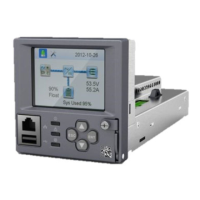Vertiv™ NetSure™ Control Unit (NCU) User Manual
DC Output and Battery Voltages
DANGER! Connecting the NCU power system to an existing power system for “Power Split” mode involves working on live
equipment carrying live loads. This system produces DC Power and may have a battery source connected to it. Although the
DC voltage is not hazardously high, the rectifiers and/or battery can deliver large amounts of current. Exercise extreme
caution not to inadvertently contact or have any tool inadvertently contact an output terminal or battery terminal or exposed
wire connected to an output terminal or battery terminal. NEVER allow a metal object, such as a tool, to contact more than
one termination or battery terminal at a time, or to simultaneously contact a termination or battery terminal and a grounded
object. Even a momentary short circuit can cause sparking, explosion, and injury. Remove watches, rings, or other jewelry
before connecting leads. Cover any live busbars with a canvas sheet to prevent short circuits caused by falling tools or parts.
Preparing the Existing and NCU Power Systems
• Install and turn-up the NCU power system as describe in the installation instructions furnished with the power system.
• Set the float voltage on both the existing and NCU power systems to the same level. Temperature compensation
functionality, if used, should be disabled on both power systems.
Paralleling the Systems
• Connect the Battery and Battery Return busbars of the NCU Power System to the main charge busbars (rectifier side of the
shunt) on the parallel power system. Size the cable for the largest current between systems.
Note 1:
The connections between the two power systems should be done with power cables appropriately sized to be
capable of carrying the maximum current that can circulate between the two power systems.
Note 2:
If the parallel power system incorporates a main plant shunt, the connections of the cables from the NCU power
system to the parallel power system shall be made on the main charge busbars (rectifier side of the shunt).
Note 3:
To compensate for voltage drop, it is recommended to connect the power system’s remote sense leads (if
available) to the same point of sensing as the parallel power system.
Note 4:
There shall be only one battery return reference (BRR) cable for the two power systems. If the cable is
appropriately sized on the parallel power system, keep it as the BRR for both power systems. If the cable is not
appropriately sized on the parallel power system, install a new BRR cable and connect it preferably to the NCU
power system since the parallel power system may eventually be phased out.
Note 5:
If battery disconnect units (BDUs) are used on the new or parallel power system, these shall be wired in such a way
as to be all triggered simultaneously in order to prevent any overloading of these.
Note 6:
For the size and number of bridge cables between the two power systems, take into consideration the voltage
drop, the available connecting points in each system, as well as the fact that these cables are unfused and shall
therefore be run on a dedicated cable rack. “C” or “H” taps may be used to make full use of available connecting
points.
Note 7:
The legacy system retains the function of its controller and the percent of load on each plant is controlled by the
NCU. Alarms may be sent individually from each plant, or combined using an NCU Interface Board and the
programmable relays resident in the controller.
Note 8:
Add a label on both power systems to indicate that these are operating in the Power Split Mode with each other.
• Optional Function Connections: The following signals from the existing system must be connected to digital inputs of the
NCU system interface board for these functions to be active: Equalize Charge in Progress, Battery Test in Progress, Load
LVD Active, and Battery LVD Active. Otherwise disable these functions.

